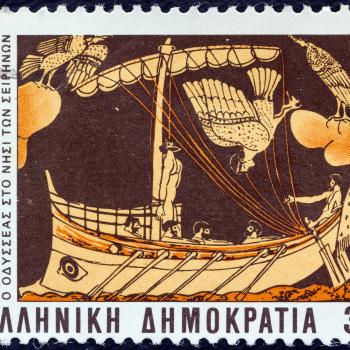Weaving the Old into the New: Pairing The Odyssey with Contemporary Works

- Preview |
- Standards |
- Resources & Preparation |
- Instructional Plan |
- Related Resources |
- Comments
Overview
After reading and discussing The Odyssey and a contemporary epic such as Running Out of Summer—a story that follows the protagonist's journey from Atlanta to Santa Monica to attend school—students select one character from each work as the basis for a comparison-contrast graphic organizer. Then, given a handout with five hypothetical contemporary situations, students determine which of the options best suits both characters. Students must justify the specific reasoning behind their decisions through their use of exact quotations and proper documentation. As an alternative or extension, students can complete the same activities with the film O Brother, Where Art Thou? or another work from the Contemporary Epic Booklist.
This lesson plan was developed as part of a collaborative professional writing initiative sponsored by the Kennesaw Mountain Writing Project (KMWP) at Kennesaw State University.
Featured Resources
The Hero's Journey: Using this online tool, students learn about the elements of the hero’s journey, analyze a text that follows the hero’s journey pattern, or start creating a hero story of their own.
Interactive Venn Diagram: Students use this online tool to compare and contrast two works of literature.
From Theory to Practice
"The first purpose of an epic poem," notes Carol Jago in With Rigor For All: Teaching the Classics to Contemporary Students, "is to entertain, to tell a story" (13). And while the excitement, adventure, and heroics inherent in reading an epic might provide substantial engagement for some students, Jago argues that teachers should not stop there. She notes that "close at heels of pleasure is the message that...we [like heroes in classical epics] must define and contest the 'issues of importance' for our own society" (13).
Jago recommends using contemporary texts to bridge the gap between the themes of a classical epic and the issues that are more immediately familiar to students. This lesson offers a creative way to make such connections between the classic and the contemporary while enhancing students' understanding and appreciation of each.
Further Reading
Common Core Standards
This resource has been aligned to the Common Core State Standards for states in which they have been adopted. If a state does not appear in the drop-down, CCSS alignments are forthcoming.
State Standards
This lesson has been aligned to standards in the following states. If a state does not appear in the drop-down, standard alignments are not currently available for that state.
NCTE/IRA National Standards for the English Language Arts
- 1. Students read a wide range of print and nonprint texts to build an understanding of texts, of themselves, and of the cultures of the United States and the world; to acquire new information; to respond to the needs and demands of society and the workplace; and for personal fulfillment. Among these texts are fiction and nonfiction, classic and contemporary works.
- 2. Students read a wide range of literature from many periods in many genres to build an understanding of the many dimensions (e.g., philosophical, ethical, aesthetic) of human experience.
- 3. Students apply a wide range of strategies to comprehend, interpret, evaluate, and appreciate texts. They draw on their prior experience, their interactions with other readers and writers, their knowledge of word meaning and of other texts, their word identification strategies, and their understanding of textual features (e.g., sound-letter correspondence, sentence structure, context, graphics).
- 4. Students adjust their use of spoken, written, and visual language (e.g., conventions, style, vocabulary) to communicate effectively with a variety of audiences and for different purposes.
- 5. Students employ a wide range of strategies as they write and use different writing process elements appropriately to communicate with different audiences for a variety of purposes.
- 6. Students apply knowledge of language structure, language conventions (e.g., spelling and punctuation), media techniques, figurative language, and genre to create, critique, and discuss print and nonprint texts.
- 7. Students conduct research on issues and interests by generating ideas and questions, and by posing problems. They gather, evaluate, and synthesize data from a variety of sources (e.g., print and nonprint texts, artifacts, people) to communicate their discoveries in ways that suit their purpose and audience.
- 8. Students use a variety of technological and information resources (e.g., libraries, databases, computer networks, video) to gather and synthesize information and to create and communicate knowledge.
Materials and Technology
- O Brother, Where Art Thou? (optional)
- Running Out of Summer by Peter E. Morgan
- The Odyssey by Homer
Printouts
- Contemporary Epic Booklist
- What Is an Epic Poem?
- Genre Comparison Graphic Organizer
- H-Chart Graphic Organizer for O Brother, Where Art Thou?
- H-Chart Graphic Organizer for Running Out of Summer
- Model Situation for O Brother, Where Art Thou?
- Model Situation for Running Out of Summer
- Writing Situations Rubric
- Writing Situations for O Brother, Where Art Thou?
- Writing Situations for Running Out of Summer
Websites
Preparation
- Before this lesson, have students read two different epics: The Odyssey, and Running Out of Summer or another work from the Contemporary Epic Booklist. The body of the lesson plan points to the resources to pair with Running Out of Summer. Resources for O Brother, Where Art Thou? are included in the Extension section and may be adapted for other works from the Contemporary Epic Booklist.
- Arrange for students to have access to Internet-connected computers for the sessions in which they will be using online tools.
- Make copies of the Writing Situations handout and the Writing Situations Rubric for each student.
- Prepare an overhead transparency or make individual copies of the Definition of Epic Poetry and Model Situation.
- Test the ReadWriteThink Hero's Journey interactive and Interactive Venn Diagram tools to familiarize yourself with them and ensure that you have the proper Flash plug-ins installed. You can download the plug-in from the technical support page.
- If you choose not to use the Interactive Venn Diagram, make individual copies of the H-Chart Graphic Organizer.
Student Objectives
Students will
- explore the characteristics of an epic.
- analyze characters from multiple texts.
- create contemporary situations involving characters from two different texts.
- demonstrate proper documentation of sources.
- reflect upon their peers' choices of characters and situation.
Session One
- Display the definition of epic poem.
- Work through the characteristics of the definition by discussing how it connects to the features of The Odyssey.
- Ask students to discuss whether Running Out of Summer is an epic.
- Encourage specific comparisons between the definition and the characteristics of Running Out of Summer.
- Explain that students will compare one character from The Odyssey with one from Running Out of Summer, based on their understanding of the characters and epics.
- Have pairs or small groups of students use The Hero's Journey interactive to begin comparing the two texts. They should create a printout of the hero's journey of the main character of both works for use in the next session. Because they may choose to focus on a character other than the hero, however, be sure to remind them to include specific references to other characters' involvement in the texts.
Session Two
- If necessary, provide additional time and access to The Hero's Journey interactive to allow students to complete their initial analysis of the two texts.
- When students have completed their work with The Hero's Journey interactive, have them brainstorm similar characters from the two texts, and list their responses on the board. If students have difficulty, suggest a character from one text and ask them if there is a similar character in the other text.
- Ask students to choose the characters that they will focus on for this activity, referring to the class list for choices.
- Provide students access to the ReadWriteThink Interactive Venn Diagram tool or give them the H-Chart Graphic Organizer handout.
- Demonstrate how to use the tool or handout. To use the H-Chart Graphic Organizer, students list individual characteristics in the vertical columns and similarities in the horizontal space.
- Ask students to compare the two selected characters using the Interactive Venn Diagram or H-Chart Graphic Organizer.
- Allow the remainder of the session for students to complete their comparison.
Session Three
- Review students’ comparisons, asking them to share any unexpected similarities or differences that they discovered as they worked.
- Explain that students will now place the characters they have chosen in hypothetical contemporary situations.
- Introduce the following hypothetical situation as a model for the class orally, or using the Model Situation handout:
You are the producer for a Survivor television program starring both Odysseus and Nick from Running Out of Summer. It’s your job to choose a setting that would provide challenges for both characters. Support your choice of setting with examples from the texts.
- Invite the class to offer suggestions for possible settings. Encourage students to provide details from the texts that back up their suggestions.
- Share a model response to the situation, focusing on a shipwreck as the setting. Write the following response on the board or refer to the Model Situation handout:
The best setting for a Survivor series for both Odysseus and Nick would be a shipwreck. Odysseus survives a shipwreck, as Homer states: “Zeus let fly/ a bolt against the ship, a direct hit. . . . All that night I drifted” (12. 340-46). In a similar way, Nick survives the rapids of Badger Creek. As he and Maria ride the rapids, “Their knuckles and fingers were white as they clung to the ropes” (Morgan 245).
- Ask students to identify how the model response provides support from the text.
- Invite students to share additional support for the setting, as appropriate.
- Referring to your class grammar text or MLA Formatting and Style Guide, discuss the use of parenthetical MLA documentation of quotations. Point to the examples in the Model Situation to demonstrate the technique.
- Pass out the Writing Situations handout and the Writing Situations Rubric and then review the expectations for students’ work.
- Allow students to begin their work in response to the situations during the remainder of class. If additional work time is needed, ask students to complete their responses for homework.
- After students have responded to all of the hypothetical situations, invite them to share one situation of their choice with the class.
- Allow class members the opportunity for verbal responses to the shared situations.
Extensions
- If students need more background on the characteristics of an epic, tap the resources in the EDSITEment lesson plan A Story of Epic Proportions: What makes a Poem an Epic?.
- Following a viewing of the movie O Brother, Where Art Thou? discuss similarities among the film, The Odyssey, and Running Out of Summer. Have students complete the Genre Comparison Graphic Organizer to explore the comparisons among the three texts in more detail.
- As an alternative to Running Out of Summer, show the film O Brother, Where Art Thou? and have students complete the same activities focusing on the movie and The Odyssey, using these alternate handouts:
- H-Chart Graphic Organizer for The Odyssey and O Brother, Where Art Thou?
- Writing Situations for The Odyssey and O Brother, Where Art Thou?
- Model Situations for The Odyssey and O Brother, Where Art Thou?
- H-Chart Graphic Organizer for The Odyssey and O Brother, Where Art Thou?
Student Assessment / Reflections
- Focus on observation as students complete the visual organizer you have chosen, either the Interactive Venn Diagram or the H-Chart Graphic Organizer, as well as The Hero's Journey interactive.
- Check for completion of the visual organizers.
- Assess the Writing Situations using either the Writing Situations Rubric or your own system for assessing student writing.

Add new comment